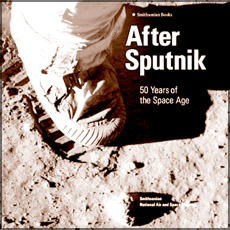Sputnik propels space age
It's 50 years since Sputnik was launched by Russia :
 The
chilly evening of October 4, 1957 is considered as some of the most
breathtaking hours in the history The
chilly evening of October 4, 1957 is considered as some of the most
breathtaking hours in the history
|

The Sputnik |
of mankind. The entire planet was impatiently waiting to see
the success of a great scientific feat. But, nobody knew whether it
would work out or not, since this was an attempt, a journey into the
unknown. What was this feat that the world was so concerned about?
This was the event that tested whether sending a man-made object into
outer space was actually possible.
As a new attempt by the Soviet Union, Sputnik 1, a 83 kilogram
aluminium sphere inserted into the nose of a Soviet R-7 ballistic
missile, was shot skyward from its launch-pad near the edge of the Kyzyl
Kum desert, about a hundred miles east of the Aral Sea to become the
first man-made object to orbit the Earth.
To the delight of everybody, the mission was a success and this
became the beginning of the Space Age. Space Age is the term used to
refer to the period comprising space exploration, space travel, space
technology and cultural development influenced by these activities.
The launch of Sputnik created this new 'age', and since then the
great scientific discoveries related to space and astronomy, exposed
many new, exciting breakthroughs which were once considered to be
completely magical.
All the scientific achievements made over the last few decades seem
as if they happened just a few years ago. But, the Space Age celebrated
its fiftieth birthday on October 4, 2007, signifying an eventful
lifespan of the Space Age up to then.
Yuri Gagarin's travel in to space, man setting foot on the Moon,
numerous space walks, the setting up of the Mir and International Space
Station, launch of the Hubble telescope, numerous missions to Mars, Moon
and other planets are a few of the amazing achievements made within the
last fifty years of the Space Age.
****

Sputnik 1
  Sputnik
1 was a 22 inch wide aluminum sphere that weighed 83 kilograms. The size
in practical terms can be stated as a bit larger than that of a
basketball. This satellite circled Earth every 96 minutes at about
17,000 mph on an elliptical path. Sputnik 1 was destroyed when it
re-entered the atmosphere after three months of flight. Sputnik
1 was a 22 inch wide aluminum sphere that weighed 83 kilograms. The size
in practical terms can be stated as a bit larger than that of a
basketball. This satellite circled Earth every 96 minutes at about
17,000 mph on an elliptical path. Sputnik 1 was destroyed when it
re-entered the atmosphere after three months of flight.
****
The
Sputnik programme
The Sputnik programme was a series of unmanned space missions
launched by the Soviet Union in the late 1950s to demonstrate the
possibility of artificial satellites. It included Sputnik 1, the first
man-made object to orbit Earth. The Russian name 'Sputnik' literally
means 'co-traveller' or 'travelling companion' or simply 'satellite'.
The world's first artificial satellite launch, under the Sputnik
missions initiated new political, military, technological, and
scientific developments. While the Sputnik launch was a single event, it
marked the start of the space race between Russia and the United States.
The surprise launch of Sputnik 1, together with the surprising
failure of the United States' first two Project Vanguard launch
attempts, shocked the United States, which responded with a number of
early satellite launches, including Explorer I, Project SCORE, Advanced
Research Projects Agency and Courier 1B.
The Sputnik missions also led to the creation of NASA and major
increases in U.S. government spending on scientific research and
education.
****
Other Sputnik missions
Sputnik 2 was launched on November 3, 1957 and carried the first live
passenger, a dog named Laika. The mission planners did not plan the safe
return of the spacecraft or its passenger, making Sputnik the first
orbital casualty and U.S. observers watched as it burned up re-entering
over North America on April 13, 1958.
The first attempt to launch Sputnik 3, on February 3, 1958, failed,
but the second on May 15 succeeded, and it carried a collection of
instruments for geophysical research.
Sputnik 4 was launched two years later, on May 15, 1960. Sputnik 5
was launched on August 19, 1960 with the dogs Belka and Strelka, 40
mice, two rats and a variety of plants on board. The spacecraft returned
to Earth the next day and all animals were recovered safely.
A variety of Venera, Vostok, Voskhod, Kosmos and other classes of
Soviet spacecraft were referred to as Sputniks by American observers,
although none of these were actually named 'Sputnik' by the Soviet
Union. A number of other missions, ranging from Sputnik 1 to Sputnik 41
have been carried out to date for various explorations.
Aravinda Dassanayake |
